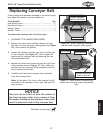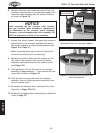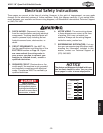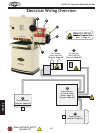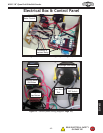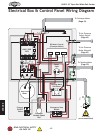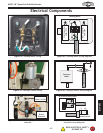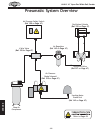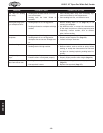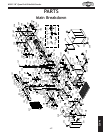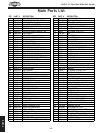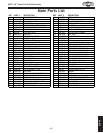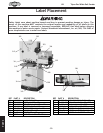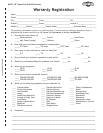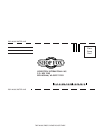
-45-
N(/(*(/Fg\e<e[N`[\9\ckJXe[\i
J<IM@:<
KiflYc\j_ffk`e^
This section covers the most common problems and corrections with this type of
machine. N8IE@E>;FEFKdXb\XepX[aljkd\ekjlek`cgfn\i`j[`jZfee\Zk\[Xe[
dfm`e^gXikj_Xm\Zfd\kfXZfdgc\k\jkfg
GIF9C<D GFJJ@9C<:8LJ< :FII<:K@M<8:K@FE
Machine does not start
or a breaker trips.
1. Switch disabling key removed.
2. Emergency stop push-button engaged/
faulty.
3. Power supply switched OFF or at fault.
4. Plug/receptacle at fault/wired wrong.
5. Start capacitor at fault.
6. Air pressure safety switch open/at
fault.
7. Motor connection wired wrong.
8. Thermal overload relay has tripped.
9. Wall circuit breaker tripped.
10. Contactor not energized/has poor con-
tacts.
11. Wiring open/has high resistance.
12. Motor ON button or ON/OFF switch at
fault.
13. Motor at fault.
1. Install switch disabling key.
2. Rotate button to reset/replace it.
3. Ensure power supply is on/has correct voltage.
4. Test for good contacts; correct the wiring.
5. Test/replace if faulty.
6. Adjust air pressure safety switch; replace if
faulty.
7. Correct motor wiring connections (Page 43).
8. Reset; adjust trip load dial if necessary; replace.
9. Ensure circuit size is correct/replace weak break-
er.
10. Test all legs for power/replace if faulty.
11. Check/fix broken, disconnected, or corroded
wires.
12. Replace button/switch.
13. Test/repair/replace.
Machine stalls or is
underpowered.
1. Workpiece material not suitable for
machine.
2. Depth of cut too much; feed rate to
fast.
3. Dust collection ducting problem.
4. Run capacitor at fault.
5. Motor wired incorrectly.
6. Plug/receptacle at fault.
7. Motor bearings at fault.
8. Machine undersized for task.
9. Contactor not energized/has poor con-
tacts.
10. Motor overheated.
11. Motor at fault.
1. Only sand wood/ensure moisture is below 20%.
2. Properly adjust depth of cut (Page 22); reduce
conveyor feed rate.
3. Clear blockages, seal leaks, use smooth wall duct,
eliminate bends, close other branches.
4. Test/repair/replace.
5. Wire motor correctly (Page 43).
6. Test for good contacts/correct wiring.
7. Test/repair/replace.
8. Clean/replace sandpaper; reduce feed rate/sand-
ing depth of cut (Page 22)
9. Test all legs for power/replace if faulty.
10. Clean motor, let cool, and reduce workload.
11. Test/repair/replace.
Machine has vibration or
noisy operation.
1. Motor or component loose.
2. Machine incorrectly mounted.
3. Motor fan rubbing on fan cover.
4. Motor bearings at fault.
5. Conveyor gearbox at fault.
1. Inspect/replace damaged bolts/nuts, and re-tight-
en with thread locking fluid.
2. Tighten mounting bolts; relocate/shim machine.
3. Fix/replace fan cover; replace loose/damaged
fan.
4. Test by rotating shaft; rotational grinding/loose
shaft requires bearing replacement.
5. Rebuild gearbox for bad gear(s)/bearing(s).



